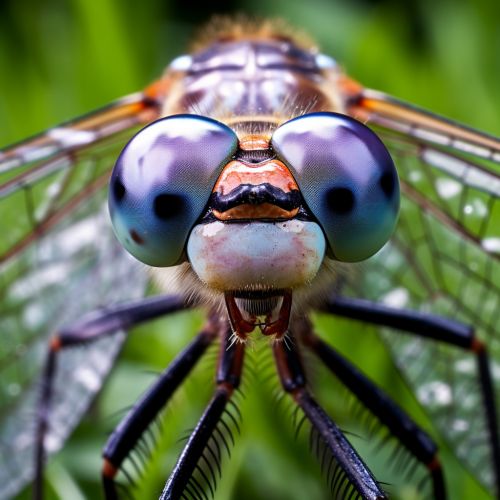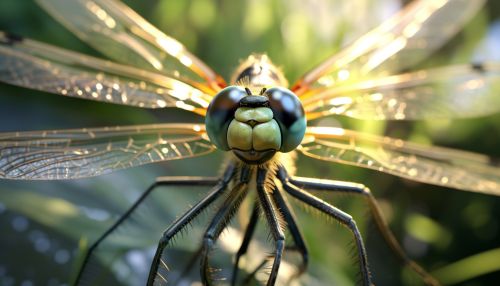Dragonfly
Introduction
The dragonfly is an insect belonging to the order Odonata, infraorder Anisoptera (from Greek ἄνισος 'unequal' and πτερόν 'wing', because the hindwing is broader than the forewing). Adult dragonflies are characterized by large, multifaceted eyes, two pairs of strong, transparent wings, sometimes with coloured patches, and an elongated body.
Anatomy and Morphology
Dragonflies possess six legs (like any other insect), but most of them cannot walk well. Dragonflies are among the fastest flying insects in the world. They are capable of reaching speeds of up to 60 km/h (37 mph) in short bursts when they are in a hurry.


Eyes
Dragonflies have very good eyesight due to their unique eye structure. Their compound eyes have up to 30,000 facets, each of which is a separate light-sensing organ or ommatidium, arranged to give nearly a 360° field of vision.
Wings
The wings of a dragonfly are among the most distinctive features of the insect. They are large, strong, and transparent, with a network of black or dark-colored veins that create a sort of stained glass effect. The wings are held flat and away from the body when at rest.
Body
The body of a dragonfly is long and slender, typically marked with bold, contrasting patterns that can be quite colorful. The body is divided into three sections: the head, thorax, and abdomen.
Life Cycle
Dragonflies have a life cycle with three stages: egg, nymph (larva), and adult. The female lays her eggs in or near water, often on floating or emergent plants. When first hatched from the egg, the nymph is tiny and lives in the water, where it undergoes a series of molts as it grows and changes into an adult dragonfly.
Egg
The female dragonfly deposits her eggs on the surface of water or on aquatic plants. The eggs are usually oval and about 0.5 to 1.0 mm in diameter.
Nymph
The nymph stage of a dragonfly may last as long as five years. During this time, the nymph feeds on small aquatic organisms, molting several times as it grows.
Adult
Once the nymph is fully grown, it climbs out of the water and undergoes its final molt, emerging as an adult dragonfly. This final transformation from nymph to adult is known as metamorphosis.
Behavior
Dragonflies are agile fliers, capable of migrating across oceans, moving in any direction, and hovering in a single spot for a minute or more. They are also known for their mating behavior, which often involves complex aerial maneuvers.
Predation and Defense
Dragonflies are predators that eat mosquitoes, and other small insects like flies, bees, ants, wasps, and butterflies. They are usually found around marshes, lakes, ponds, streams, and wetlands because their larvae, known as "nymphs", are aquatic.
Relationship with Humans
In some cultures, dragonflies are considered to bring good luck. They are also beneficial to humans because they eat mosquitoes and other insects that can spread disease. However, they can also be a nuisance when they swarm in large numbers.
Conservation Status
Many dragonfly species are under threat due to loss of suitable wetland habitat. Conservation efforts are underway in many parts of the world to preserve the habitats of these important insects.
